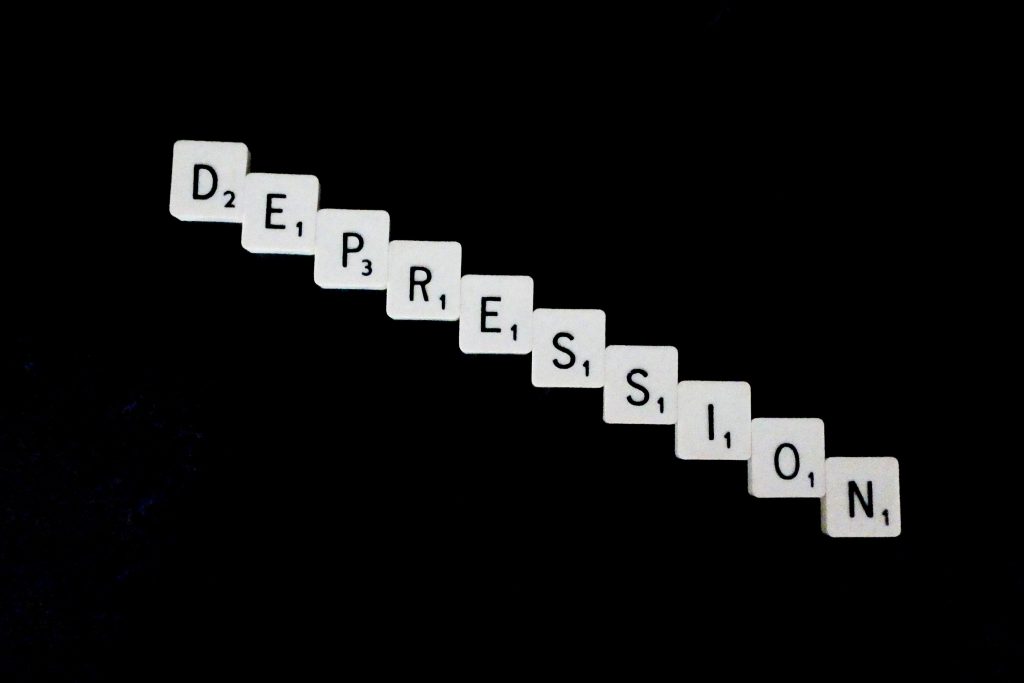
Stigma towards depression continues to be pervasive, despite mounting evidence that depression is a leading cause of avoidable suffering in the world, and that effective intervention strategies exist for promotion, prevention, treatment, and support (Herrman, 2022).
Mental health-related stigma is defined as a combination of a lack of knowledge, prejudice and discrimination against those with mental health difficulties (Corrigan, 2005). It can manifest itself in several ways, including:
- Perceived stigma (i.e., beliefs about the attitudes of others)
- Enacted stigma (i.e., experienced stigma)
- Treatment stigma (i.e., negative attitudes or beliefs about receiving treatment)
- Self-stigma (one’s own thoughts and beliefs about their own depression; Griffiths, 2008; Fox, 2018).
Experiencing stigma for individuals with mental disorders has been described as a ‘double jeopardy’, referring to experiencing the impact of the mental health disorder as well as the severe consequences of stigma. Many people even describe the stigma they experience as being worse than the mental health condition itself (Thornicroft, 2022).
Worldwide, stigma towards people living with depression has been associated with negative outcomes, including low levels of help-seeking, poor treatment adherence and outcomes, low quality of life, and risk of suicidal thoughts and behaviour. While data on public attitudes toward depression is available for some high-income countries, evidence for widespread reduction in public stigma over recent decades is scarce (Hermann, 2022).
This systematic review and meta-analysis by Du et. al. (2023) attempts to address this gap through a first-time analysis of data on the global prevalence of self-stigma in depression. Unlike previous studies, this review examined geographical differences in self-stigma and associated risk and protective factors. Specifically, this review aimed to:
- Review and synthesise the evidence on the prevalence of depression self-stigma across different continents
- Identify risk and protective factors of depression self-stigma
- Identify limitations of the current evidence.

In the context of depression, self-stigma is associated with reduced help-seeking and treatment adherence, increased depressive symptoms, and increased risk of suicidality, meaning it is important to understand the scope of this issue.
Methods
The authors conducted a search of four online databases to identify studies which:
- Were in English
- Involved samples of people with depression
- Assessed self-stigma or it’s correlates with a validated measure
- Provided quantitative data on prevalence and/or correlates of self- stigma.
Subgroup analyses were performed to examine the differences in mean values across geographic areas only for studies that measured depression self-stigma using the Internalized Stigma of Mental Illness Scale (ISMI). Random effects models were employed for data synthesis, given that various covariates could influence the effect sizes of included studies.
Study quality was assessed using an 11-item scale for cross-sectional studies provided by the Agency for Healthcare Research and Quality (AHRQ). 38 studies were rated as moderate quality, and 18 studies were rated as high quality. No studies were low quality.
Results
56 studies met the inclusion criteria. Most included studies were cross-sectional (87.5%), with 39.3% of studies including participant samples with multiple mental health diagnoses. 62.5% of studies used the ISMI to measure self-stigma and provided mean values of self-stigma.
20 studies compared levels of self-stigma across different diagnoses, with 12 reporting significant differences among clinical subgroups (e.g., six studies showed higher self-stigma scores in schizophrenia than in depression and six studies showed higher self-stigma scores in depression than in schizophrenia).
Most included studies were conducted in Asia, Europe, and North America. Altogether, the studies included 11,549 participants, with sample sizes across studies ranging from 14 to 1379. Most studies (62.5%) include female outpatient participants.
Prevalence of depression self-stigma
- Overall prevalence: The pooled prevalence of (moderate to high) self-stigma for depression across studies was 29%. The pooled prevalence of self-stigma in studies with patients with depression alone was 34%. This was higher than in the sub-group where the sample included multiple mental disorders (23%), but this difference was not statistically significant.
- Demographic factors: Male identifying (r = 0.06, 95% CI [0.00 to 0.11]) and non-White individuals (r = 0.10, 95% CI [0.01 to 0.19]) were positively and modestly associated with self-stigma. Having a partner or being married (r = -0.22; 95% CI [-0.30 to -0.14]) was negatively associated with self-stigma.
- Regional levels: The variation of self-stigma across geographic areas was marginally non-significant (p = 0.06), with findings that depression self-stigma was higher in participants in Africa, Asia and North America as compared to Europe. Results also suggested that ethnic minorities report higher self-stigma, but socio-cultural factors (e.g., cultural beliefs, mental health literacy levels, access to medical and health resources, cultures endorsing collectivism) were not consistently or strongly correlated with self-stigma in the studies in this review, even though they were cited as potential explanations.
Risk factors and protective factors
Six risk factors were positively associated with self-stigma:
- Depression symptom severity
- Illness duration
- Public stigma
- Treatment stigma
- Perceived stigma
- Enacted stigma
Seven protective factors were identified:
- Age at onset
- Treatment attitude
- Quality of life
- Social relationships
- Self-esteem
- Extroversion
- Social functioning

Du et al. (2023) found that the pooled worldwide prevalence of moderate to high self-stigma in depression was 29%.
Conclusions
This review concluded that people living with depression are at considerable risk of internalising negative stereotypes and discrimination associated with depression. Prominent risk factors were identified, including depression symptom severity and stigma-related factors; but protective factors were also identified, such as quality of life and self-esteem.
Given the small degree of geographic variation of self-stigma in this study, the authors suggest further examination of contextual and institutional factors, such as public health policies and mental health systems, and for future research to explore the underlying mechanisms involved in these findings about self-stigma.

Protective factors against self-stigma in depression was identified, including quality of life and social relationships. Risk factors were also found, such as symptom severity and illness duration.
Strengths and limitations
Strengths
- Many previous studies have provided insights about the effects of stigma, but this review makes a new contribution in (i) classifying risk and protective factors and discerning the nature of their relationship with stigma and (ii) stratifying findings by geographic parameters.
- The review has many methodological strengths such as adherence to PRISMA guidelines and pre-registration on PROSPERO. Studies were also of high or moderate quality, thereby improving the reliability of the findings.
- Recommendations for how the findings of this review can be put into practice are another strength. For example, the authors suggest expanding education and contact-oriented interventions beyond knowledge improvement towards psychosocial issues related to depression.
- This study also highlights possible directions for intervention as well as research to examine the relative efficacy of using different approaches to addressing the self-stigma of people living with depression.
Limitations
- Methodological limitations include the use of a random effects model for meta-analysis. This type of model typically requires a lot of data and uses more assumptions due to the estimation of an additional parameter (the between-study variance). In addition, this model might not eliminate heterogeneity completely, as there may be other sources of variation not captured by the model. For example, in the includes studies in this review, measurements of self-stigma and other outcome variables were different, and these may have influenced the results and their levels of heterogeneity.
- As most studies were cross-sectional, the analysis only examines correlational rather than causal relationships. For example, the findings of this review help us understand factors associated with stigma, but these do not suggest what might be causing it or why.
- Factors identified in qualitative studies included in the systematic review were not captured in the meta-analysis findings.
- Regional representation of the findings should be interpreted with caution. Most studies were from Asia and Europe. Only a few studies from Africa and Australia were included, while no studies were from South America. Relatedly, due to language limitations (English studies only) it is possible that other relevant studies were missed in the study search.

While the study adhered to best practice guidelines, caution needs to be taken due to heterogeneity, the use of cross-sectional data, and search strategy restrictions.
Implications for practice
The findings from this study have important implications for clinical and community-based programmes and researchers.
For practice
- Insights can inform de-stigmatisation practices and interventions for clinicians and policymakers to improve clinical and psychosocial outcomes for people living with depression. The authors outline examples for building psychosocial skills and contact-oriented interventions such as helping people living with depression to foster self-esteem, self-efficacy and to build public awareness of depression and its treatments.
- Focus increased efforts to mitigate self-stigma in communities that may be especially prone to the negative impacts of self-stigma. For example, focusing on men’s mental health and on people marginalised due to ethnicity/race.
For research
- Develop and evaluate de-stigmatisation interventions incorporating the different risk and protective factors identified.
- Examine the effectiveness of existing interventions aimed at reducing self-stigma.
- Examine the underlying mechanisms involved in understanding and addressing self-stigma for depression.
- Examine contextual and institutional factors, such as public health policies and mental health systems and how these affect variation of self-stigma across geographies.

Going forward, it is important for de-stigmatisation to be consistently incorporated within treatments for depression, with emphasis on addressing identified risk factors and fostering potential protective factors.
Statement of interests
None.
Links
Primary paper
Du, N., Chong, E. S. K., Wei, D., Liu, Z., Mu, Z., Deng, S., & Huang, Y.-T. (2023). Prevalence, risk, and protective factors of self-stigma for people living with depression: A systematic review and meta-analysis. Journal of Affective Disorders, 332, 327–340.
Other references
Corrigan, P. W., Kerr, A., & Knudsen, L. (2005). The stigma of mental illness: Explanatory models and methods for change. Applied and Preventive Psychology, 11(3), 179–190.
Fox, A. B., Earnshaw, V. A., Taverna, E. C., & Vogt, D. (2018). Conceptualizing and measuring mental illness stigma: The Mental Illness Stigma Framework and critical review of measures. Stigma and Health, 3(4), 348–376.
Griffiths, K. M., Christensen, H., & Jorm, A. F. (2008). Predictors of depression stigma. BMC Psychiatry, 8(1).
Herrman, H., Patel, V., Kieling, C., Berk, M., Buchweitz, C., Cuijpers, P., Furukawa, T. A., Kessler, R. C., Kohrt, B. A., Maj, M., McGorry, P., Reynolds, C. F., Weissman, M. M., Chibanda, D., Dowrick, C., Howard, L. M., Hoven, C. W., Knapp, M., Mayberg, H. S., … Wolpert, M. (2022). Time for united action on depression: A Lancet–World Psychiatric Association Commission. The Lancet, 399(10328), 957–1022.
Thornicroft, G., Sunkel, C., Alikhon Aliev, A., Baker, S., Brohan, E., el Chammay, R., Davies, K., Demissie, M., Duncan, J., Fekadu, W., Gronholm, P. C., Guerrero, Z., Gurung, D., Habtamu, K., Hanlon, C., Heim, E., Henderson, C., Hijazi, Z., Hoffman, C., … Winkler, P. (2022). The Lancet Commission on ending stigma and discrimination in Mental Health. The Lancet, 400(10361), 1438-1480.
Photo credits
- Photo by Emma Simpson on Unsplash
- Photo by Tiago Bandeira on Unsplash
- Photo by Nick Fewings on Unsplash
- Photo by Surface on Unsplash
- Photo by Lukas Blazek on Unsplash
- Photo by Bewakoof.com Official on Unsplash
